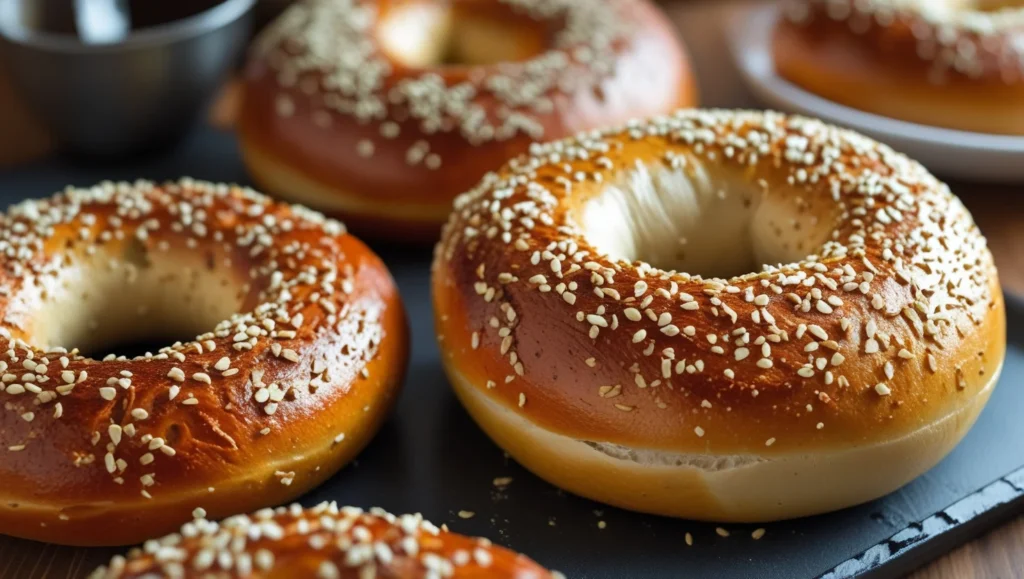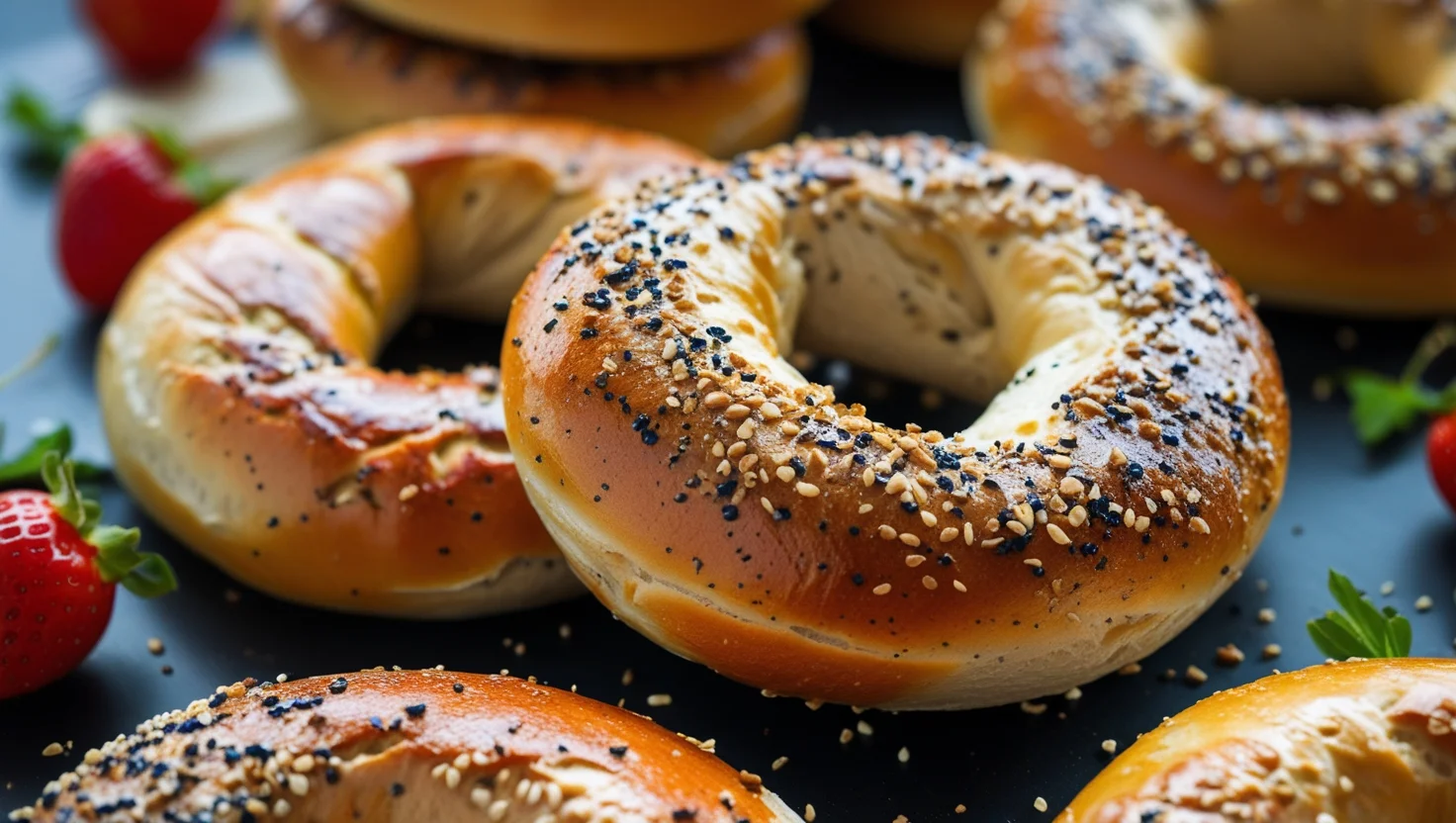Table of Contents
Introduction
What are 2-Ingredient High-Protein Bagels?
2-Ingredient High-Protein Bagels are a simple, homemade alternative to traditional bagels, made using just self-rising flour and Greek yogurt. These easy-to-make bagels are packed with protein, thanks to the inclusion of Greek yogurt, making them a nutritious choice for breakfast or snacks. Unlike conventional bagels, which often require lengthy proofing and multiple ingredients, this recipe is a time-saver without sacrificing taste or texture.
Why are they trending on social media?
These bagels have gained massive popularity on platforms like TikTok and Instagram due to their simplicity, nutritional value, and versatility. Influencers and food enthusiasts have embraced this recipe for its ability to deliver bakery-quality results with minimal effort. Their viral appeal lies in their relatability—anyone can whip them up at home, even with limited baking experience.
Overview of health benefits and simplicity
Not only are these bagels convenient, but they also offer several health benefits. With approximately 12 grams of protein per serving, they support muscle growth, satiety, and overall nutrition. Additionally, the use of Greek yogurt reduces the fat content compared to traditional bagels while adding gut-friendly probiotics. Their quick preparation and versatility in toppings make them a go-to choice for busy individuals seeking a healthy yet indulgent treat.

Ingredients and Their Benefits
Self-Rising Flour
What it is and why it’s ideal for this recipe: Self-rising flour is a type of flour that already contains a leavening agent, typically baking powder, and salt. This makes it a convenient choice for recipes like these high-protein bagels, as it eliminates the need for additional yeast or separate leavening agents. The inclusion of self-rising flour in this recipe allows the dough to rise naturally during baking, giving the bagels a light and airy texture without the hassle of waiting for yeast to activate or rise.
Nutritional value and alternatives: Self-rising flour provides a basic source of carbohydrates and small amounts of protein. A typical serving contains around 95 calories and 20 grams of carbohydrates. It’s important to note that self-rising flour isn’t particularly high in nutrients beyond its carbohydrate content. For those looking for alternatives, you can substitute whole wheat self-rising flour to increase fiber content or use a gluten-free self-rising flour blend for those with gluten sensitivities.
Greek Yogurt
Role in the recipe: Greek yogurt is a key ingredient in this 2-ingredient bagel recipe, providing moisture to the dough while helping it bind together. The thick consistency of Greek yogurt enhances the texture, making the bagels chewy yet soft on the inside with a slightly crisp exterior. Additionally, it adds a slight tang that complements the neutral flavor of the flour, creating a balanced taste.
Protein content and health benefits: Greek yogurt is a standout ingredient in this recipe due to its high protein content. A 6-ounce serving typically contains around 15 grams of protein, which helps support muscle growth and repair. It’s also rich in probiotics, promoting healthy digestion, and is an excellent source of calcium, which supports bone health. With its naturally low sugar content, Greek yogurt is a healthier alternative to many other types of yogurt.
Substitutes for dietary restrictions: For those who follow a dairy-free diet, there are several substitutes for Greek yogurt. Options like almond milk yogurt, coconut yogurt, or soy yogurt can work well in this recipe. When choosing a substitute, ensure that it has a similar thickness to Greek yogurt to maintain the right dough consistency, and look for options with added protein to preserve the health benefits.

Step-by-Step Recipe Guide
Required Equipment
To make your 2-ingredient high-protein bagels, you will need the following basic equipment:
- Mixing bowls – To combine the ingredients.
- Baking sheets – For placing your shaped bagels in the oven.
- Measuring spoons and cups – For accurate measurements of self-rising flour and Greek yogurt.
- Spoon or spatula – To mix the dough.
- Baking paper (optional) – To prevent the dough from sticking to the baking sheet.
- Oven – To bake the bagels at the right temperature for optimal results.
Preparing the Dough
To start, measure your self-rising flour and Greek yogurt and place them in a large mixing bowl. Begin by stirring them together with a spoon or spatula until the dough begins to form. The dough will likely be slightly sticky. If it feels too wet, sprinkle a little more self-rising flour into the bowl. Mix until you have a soft dough with a consistency that holds together without being overly dry. Aim for a smooth texture without overworking the dough, as this can make the bagels dense. Once the dough is ready, transfer it to a clean, lightly floured surface to prepare for shaping.
Shaping the Bagels
Now it’s time to shape the dough into bagels. Divide the dough into 4-6 equal pieces, depending on your preferred bagel size. Roll each piece into a ball and then use your finger to make a hole in the center, gently stretching and shaping the dough until you have a round bagel shape. The hole should be wide enough to prevent it from closing up during baking. Place each shaped bagel onto a baking sheet lined with parchment paper.
Baking Instructions
Preheat your oven to 375°F (190°C). Place the baking sheet in the oven and bake for 18-20 minutes, or until the bagels are golden brown and cooked through. The bagels will rise slightly and should have a lightly crispy exterior. For an extra golden color, you can brush the bagels with a little olive oil or melted butter before baking.
Tips for perfect browning and texture: Keep an eye on the bagels towards the end of the baking time. If they are not browning to your liking, you can broil them for 1-2 minutes at the end. Just be sure to watch closely to avoid burning.
Adding Toppings
Once the bagels are baked and cooled slightly, it’s time to add toppings! For sweet options, try a sprinkle of cinnamon sugar or raisins mixed into the dough. If you prefer savory, top your bagels with everything bagel seasoning, sesame seeds, or a light coating of garlic powder. You can also experiment with other toppings like dried herbs or cheese for added flavor.
Nutritional Breakdown
Protein, carbs, and calories per bagel: Each 2-ingredient high-protein bagel provides a well-balanced macronutrient profile. On average, each bagel contains:
- Protein: 12-15 grams, thanks to the Greek yogurt.
- Carbohydrates: 20-25 grams, primarily from the self-rising flour.
- Calories: Around 150-200 per bagel, depending on the exact proportions and toppings used.
Comparison to store-bought bagels: Traditional store-bought bagels typically contain around 10 grams of protein, 40-50 grams of carbohydrates, and about 250-300 calories. The high-protein bagels made with Greek yogurt have significantly fewer calories and carbohydrates, making them a healthier alternative. Additionally, the homemade version is free of preservatives and artificial ingredients commonly found in store-bought bagels.
By using self-rising flour and Greek yogurt, these bagels also provide extra nutrients like calcium and probiotics, which store-bought varieties may lack. This makes them not only a healthier choice but also a more satisfying option for those looking to boost their protein intake while controlling calorie consumption.
Creative Ways to Enjoy Your Bagels
Breakfast Ideas
- Bagel with cream cheese and smoked salmon: Start your day with a delicious, protein-packed breakfast by spreading cream cheese on your bagel and topping it with slices of smoked salmon. Add a sprinkle of capers, red onion, and fresh dill for extra flavor and a satisfying start to your morning.
- Egg and avocado bagel sandwich: For a wholesome breakfast, toast your bagel and fill it with scrambled eggs and mashed avocado. Add a pinch of salt and pepper, and top with fresh tomato slices and a drizzle of hot sauce for an energizing meal that’s rich in protein, healthy fats, and fiber.
Lunch and Snacks
- Turkey and spinach bagel sandwich: Turn your bagel into a savory lunch option by filling it with lean turkey slices, fresh spinach, and your favorite mustard or light mayo. This sandwich is both filling and nutritious, offering a great balance of protein and greens to keep you energized throughout the afternoon.
- Peanut butter and banana bagel snack: For a quick and satisfying snack, spread peanut butter on your bagel and top it with banana slices. This combination provides a great balance of protein, healthy fats, and carbs, making it perfect for a post-workout snack or a midday energy boost.
Dinner Possibilities
- Mini bagel pizzas: Transform your bagels into personal-sized pizzas for a fun and easy dinner. Spread a thin layer of marinara sauce on the bagel, add your favorite toppings like mozzarella cheese, pepperoni, or veggies, and bake until the cheese is bubbly and golden. These mini pizzas are a great way to enjoy a healthier version of pizza with a high-protein twist.
- Side dish for soups and stews: Serve your homemade bagels as a side with hearty soups or stews. They pair perfectly with creamy soups like tomato or chicken noodle, adding a comforting, filling element to the meal. You can even dip them into the soup for extra flavor and texture!
Common Questions About 2-Ingredient High-Protein Bagels (FAQ)
Can I make these bagels gluten-free?
Yes, you can make these bagels gluten-free by using a gluten-free self-rising flour blend. Many gluten-free flours are available that include a mix of rice flour, potato starch, and tapioca flour, with added leavening agents. Be sure to choose a high-quality, gluten-free self-rising flour for the best texture and results. You can also experiment with using almond flour or coconut flour, though these may result in a denser bagel, so you might need to adjust the amount of liquid to get the right dough consistency.
How can I store these bagels?
To keep your bagels fresh, store them in an airtight container or a resealable plastic bag at room temperature for up to 2 days. If you prefer to keep them longer, place them in the fridge, where they will stay fresh for up to a week. To refresh a bagel, simply toast it before serving for a warm and crisp texture.
Can I freeze the dough or the baked bagels?
Yes, you can freeze both the dough and the baked bagels for long-term storage:
- Frozen dough: Shape the dough into bagels and freeze them on a baking sheet before transferring to a freezer bag. When ready to bake, let them thaw in the fridge overnight and bake as usual.
- Frozen baked bagels: Cool the baked bagels completely before placing them in a freezer bag. To reheat, simply toast them directly from the freezer for a fresh, crispy bagel.
What if I don’t have self-rising flour?
If you don’t have self-rising flour, you can easily make your own by combining 1 cup of all-purpose flour, 1 ½ teaspoons of baking powder, and ½ teaspoon of salt. This mixture will act as a suitable substitute for self-rising flour.
How do I make them crispier or softer?
To make your bagels crispier, increase the baking time by a few minutes or broil them for the last 1-2 minutes to achieve a golden, crisp crust. For softer bagels, reduce the baking time slightly or wrap them in a damp towel right after baking to keep the moisture in. You can also try lowering the oven temperature slightly to avoid over-browning while still cooking them through.
Conclusion
These 2-ingredient high-protein bagels are a fantastic choice for anyone looking for a quick, healthy, and versatile snack or meal option. The simplicity of the recipe, using just self-rising flour and Greek yogurt, makes it an easy go-to for busy mornings or meal prep. Not only are they quick to make, but they also pack a punch of protein, making them a great option for a balanced, filling breakfast or lunch.
In addition to being a nutritious choice, these bagels are highly customizable, allowing you to experiment with different toppings and add-ins. Whether you prefer sweet flavors like cinnamon sugar or savory options like everything bagel seasoning, you can create a bagel that fits your tastes perfectly. With their light and chewy texture, these bagels are sure to satisfy your cravings while keeping you on track with your health goals.
I encourage you to give this recipe a try and enjoy the benefits of a healthier, homemade bagel. Don’t forget to share your results with us on social media or leave a comment with your feedback! Whether you’re adding your own twist to the recipe or enjoying them as is, these bagels are sure to become a new favorite in your kitchen.
For more healthy recipe inspiration, check out our Chicken Cobb Salad recipe or try a comforting Swamp Soup recipe. If you’re looking for more easy and filling meals, don’t miss out on our Chicken Alfredo Pasta Bake recipe. Enjoy your cooking journey and keep exploring delicious options like our Air-Fryer Southern Fried Chicken for healthy, tasty meals.

